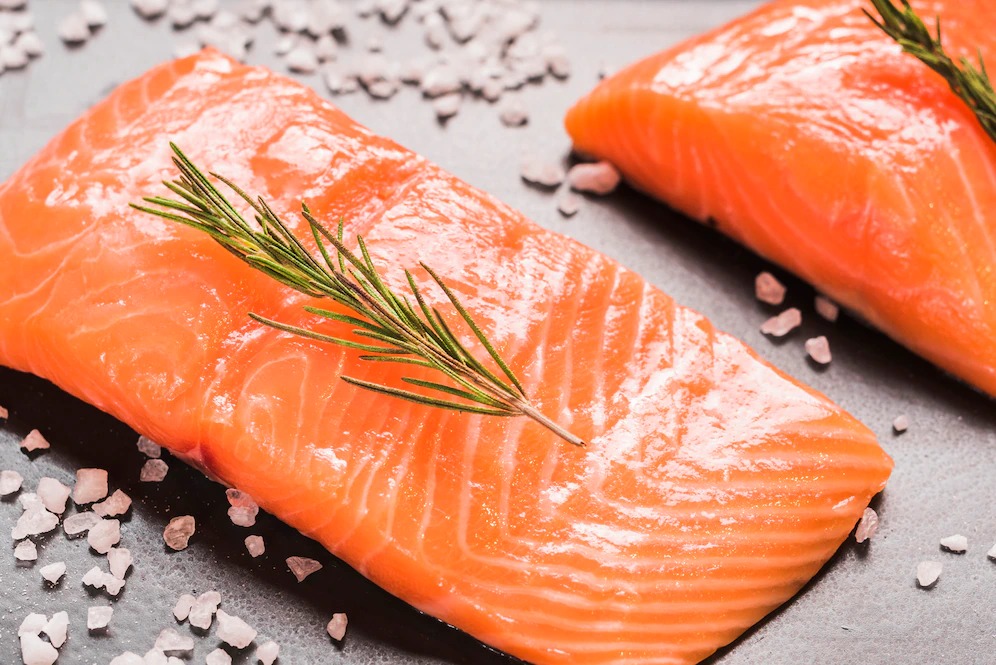
There are many different ways to cook salmon, but there are some basic rules that can be used to make it taste delicious. In this article, we’ll cover Stovetop salmon, Oven-roasted salmon, and Poaching salmon. You’ll also learn about the best side dishes to serve with your salmon.
Poaching salmon
Table of Contents
The best way to prepare poached salmon is by using a high-quality, wild-caught fish. If you choose this option, you should use a pan that can accommodate the thickness of your fillet. The poaching liquid should be just hot enough to cover the salmon. Poach the salmon for approximately 8 to 10 minutes. After this time, you can serve it with lemon slices.
The salmon filets should be extra fresh to achieve the best results. To ensure that your salmon is extra fresh, make sure to choose filets that are firm, translucent, and bright. The color of salmon will vary between species, but color is not necessarily an indicator of freshness. It should also not smell fishy, which means you should avoid buying stale or undercooked salmon.
Poaching salmon is a very simple process. To do so, you should prepare a liquid with fresh ingredients. You should add water or wine, lemon, and onion. Add a few fresh herbs, like dill, parsley, and thyme, to the liquid. The salmon should poach in the liquid for 5 to 8 minutes.
Poached salmon is served hot or cold. The poaching liquid can also be used to make a sauce or to top a salad. You can even serve it with roasted potatoes if you’d like. It’s an excellent choice for a simple dinner. When serving, serve it with some lemon juice, dill, mustard, and sour cream.
When poaching salmon, you should use fresh herbs. These are great additions to the poaching liquid because they add flavor to it. You can add dill, parsley, and white wine to the liquid.
Oven-roasted salmon
To make oven-roasted salmon, first prepare a brine by combining 4 cups of water with three tablespoons of salt. Let the fish sit in the brine for 15 minutes before baking. This will allow the salmon to be cooked evenly. You may want to add lemon or fresh herbs to the brine, too, as they give the salmon a lovely, gooey flavor.
You can also broil the fish to impart a deeper flavor to the surface. Do not broil it for more than two minutes. Broiling deepens the flavor of the fish and gives it roasted notes. Skip this step if you’re only after medium-cooked fish. Once the salmon is done, it should easily flake with a fork and should be opaque and glossy.
If you’ve made more than one batch of oven-roasted salmon, you can freeze some of them. Be sure to wrap them in parchment paper to prevent them from sticking. Salmon can also be refrigerated for up to five days after cooking. To reheat leftover salmon, simply follow the instructions in the recipe.
Salmon is a versatile food that can be served with various sides and vegetables. You can also use a fillet to make a tasty salad. Combine it with fresh radishes and veggies for a colorful meal. A simple lemon butter sauce is a good way to add flavor without too much work.
To cook salmon in the oven, make sure you remove the skin. This will help to keep the salmon moist and flavorful. The salmon should also be seasoned before cooking to ensure the best results. It’s also helpful to preheat the oven before baking it. To prevent it from sticking to the pan, you can line it with parchment paper.
Stovetop salmon
To cook salmon on the stovetop, follow a few simple steps. First, ensure that the salmon is skin side down. This will help keep the inside moist and flaky. After that, coat the salmon in half a tablespoon of olive oil and season with salt and pepper. Once the fish is on the stovetop, cook it for 2 to 4 minutes on each side.
Once the pan is hot, add butter or extra virgin olive oil. After the butter or olive oil is melted, place the salmon on the pan. Cook it until the internal temperature reaches 145 degrees F. Thicker fillets may require more time to cook. Keep the skin on the salmon after it’s cooked so it doesn’t become soggy.
Next, you should flip the salmon. The salmon will cook on both sides, so it’s important to turn it over after about a minute. It will continue to cook for a couple minutes more. The result will be tender and flaky fish with super-crisp skin. It’s a simple method that produces great tasting salmon.
Before cooking the salmon on the stovetop, you should bring it to room temperature. To make sure it’s perfectly cooked, season the fillets with salt and pepper. Heat the pan over medium-high heat for about 3 minutes. Place the salmon on the hot pan and sprinkle with 1/2 teaspoon of salt and pepper. The salmon should be done in about four to six minutes per half inch of thickness.
After the salmon is coated with oil, it’s time to season it. Sprinkle the salmon with salt and pepper and heat it until it’s 80% done. Ideally, salmon should have an internal temperature of 100 degrees F.
Oven-roasted salmon with side dishes
One of the easiest ways to enhance your oven-roasted salmon is to pair it with roasted vegetables. Asparagus, for example, is a great option as it has a light flavor that goes perfectly with salmon. Roasted bell peppers can also be a great addition because they add some depth to your dish.
To make this dish even more delicious, you can add any number of side dishes. For instance, you can serve roasted potatoes with your salmon or roasted root vegetables. These are all perfect for this dish. Make sure to use small, thinly-skinned potatoes if possible. If you don’t have this on hand, you can use any small potatoes instead.
Salmon pairs beautifully with citrusy side dishes, including lemon pasta. This tangy and fresh side dish picks up the salmon’s flaky bits. Lemon pasta is also loaded with nutrients. For an additional kick, you can top it with fresh ground pepper and capers. Another great side dish is broccolicolini, a type of broccoli that has long, delicate stalks. It goes well with salmon and tastes delicious with a little lemon juice and olive oil.
If you want to make your meal more appealing, consider trying one of the many recipes available online. Salmon is super healthy and delicious, and its flavor can be accentuated by many different sides. You can serve it for breakfast, lunch, or dinner. As long as you have the time to make the right preparations, you can enjoy delicious salmon anytime.
You can also serve salads with salmon. Asparagus is one of the most healthy vegetables available. It is packed with nutrients and is an excellent side dish. You can make a fresh and healthy salad with it.
Oven-roasted salmon with sweet peas and saffron
To make this dish, you will first need to season the salmon with salt and garlic powder. Then, place the salmon in a cast-iron skillet and cook it skin side down for about five to six minutes. Flip the salmon over and cook it for two or three more minutes. You may also cook it in the oven.
To make this dish easier to prepare, you can also prepare the vegetables and herbs in advance. You can also prepare a spice blend and add it to the meal when you are preparing it. It will also enhance the flavor of the salmon. The white miso will add depth to the dish. However, if you are not a fan of miso, you can use soy sauce instead.
The salmon will be well-browned and flaky if you bake it under the broiler. The high heat of the broiler will also help you brown the fish without overcooking it. Make sure to use a rack 6 inches off the top of the oven. Season the salmon with salt and pepper. Place it on the rack and cook for seven to 10 minutes. Make sure the internal temperature of the fish reaches 115 to 125 degrees Fahrenheit.
You can serve this salmon dish with a side dish of quinoa or peas. If you prefer something different, try pairing it with lemon juice, fresh chives, or arugula. All of these foods will enhance the flavor of salmon dish.

I’m Leon Todd and my passion for cooking is my life goal. I’m the owner and operator of Davieschuckwagon.com, a website that specializes in providing high-quality cooking information and resources. I love to experiment with new flavors and techniques in the kitchen, and I’m always looking for ways to improve my skills.
I worked my way up through the ranks, taking on more challenging roles in the kitchen. I eventually became a head chef.
Cooking is more than just a job to me – it’s a passion that I want to share with the world.

